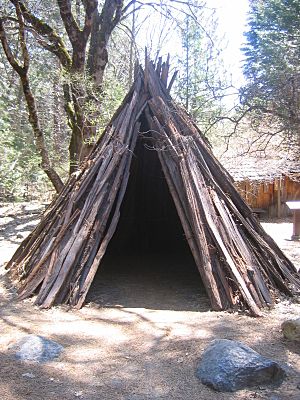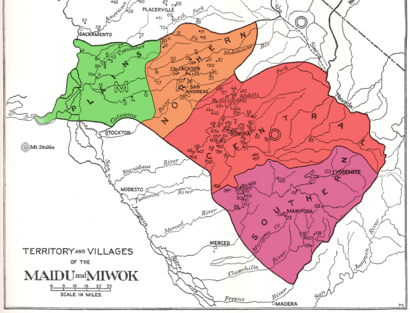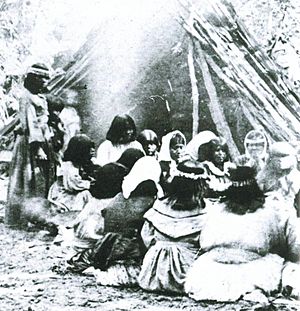Plains and Sierra Miwok facts for kids

A Sierra Miwok cedar bark umuucha cabin reproduction in Yosemite Valley. The material came from lumbering operations of 19th century miners. Previously the Miwok lived in rounded huts made of brush and mud.
|
|
| Total population | |
|---|---|
| 1770: 9,000-17,800 1848: 6,000 1880: 100 1910: 670 |
|
| Regions with significant populations | |
Sierra Nevada, Central Valley |
|
| Languages | |
| Utian: Plains Miwok, Northern Sierra Miwok, Central Sierra Miwok, Southern Sierra Miwok |
|
| Religion | |
| Kuksu Miwok religion |
|
| Related ethnic groups | |
| Other Miwok peoples: Coast Miwok, Lake Miwok, and Bay Miwok |
The Plains and Sierra Miwok were a large group of Native American people who originally lived in California. Their homeland covered parts of the Sacramento Valley, San Joaquin Valley, and the Sierra Nevada mountains.
Contents
Where the Miwok Lived
The Plains and Sierra Miwok traditionally lived in the western Sierra Nevada mountains. This area was between the Fresno River and Cosumnes River. They also lived in the eastern Central Valley of California. Another important area was the northern Sacramento–San Joaquin River Delta. This is where the Cosumnes River, Mokelumne River, and Sacramento River meet.
Today, many Sierra Miwok people live in or near their traditional lands. They live in places called Indian rancherias, including:
- Buena Vista Rancheria
- Chicken Ranch Rancheria
- Jackson Rancheria
- Sheep Ranch Rancheria
- Shingle Springs Rancheria
- Tuolumne Rancheria
- Wilton Rancheria
Miwok Culture and Traditions

The Plains and Sierra Miwok people were hunters and gatherers. This means they found their food by hunting animals and gathering plants. They lived in small local groups and did not have one main leader for everyone. They are very skilled at making baskets, and this tradition continues today.
Miwok Beliefs and Religion
The original Plains and Sierra Miwok people had beliefs that included Shamanism. One important part of their religion was the Kuksu religion. This religion was practiced in Central and Northern California. It involved special acting and dancing ceremonies with traditional costumes. There was also an annual morning ceremony and special events for young people becoming adults. Shamans would connect with the spirit world. Men had a special group that met in underground dance rooms. The Kuksu religion was shared with other Native American groups in Central California, like the Pomo, Maidu, Ohlone, Esselen, and northern Yokuts.
Traditional Stories and Myths
The Plains and Sierra Miwok have many myths, legends, tales, and historical stories. These stories are a big part of their culture.
Miwok Mythology
Miwok mythology is similar to other Native American groups in Central and Northern California. The Plains and Sierra Miwok believe in animal and human spirits. They see animal spirits as their ancestors. Coyote is an important figure in their stories. He is seen as their ancestor and a creator god.
Miwok Groups and Languages
There were four main groups of Plains and Sierra Miwok people. Each group had its own language:
- Plains Miwok
- Northern Sierra Miwok
- Central Sierra Miwok
- Southern Sierra Miwok
Plains Miwok People
The Plains Miwok lived in the Central Valley. Specifically, they were in the Sacramento-San Joaquin Delta area. This includes parts of modern southern Sacramento County, eastern Solano County, and northern San Joaquin County. They spoke the Plains Miwok language. This language belongs to the Miwokan branch of the Utian language family.
Plains Miwok Villages
Early researchers recorded many Plains Miwok villages. Later studies showed that these villages were part of larger local groups. Some important villages and groups included:
- On the Cosumnes River: Chuyumkatat, Lulimal, Mayeman, Mokos-unni, Sukididi, Supu, Tukui, Yomit
- Near the Cosumnes River: Umucha, Yumhui
- On the Mokelumne River: Lel-amni, Mokel(-unni), Sakayak-unni
- On the east bank of Sacramento River below Sacramento: Hulpu-mni
- On Jackson Creek: Ochech-ak
Some important landholding groups during the time of Spanish settlement were:
- Anizumne near Rio Vista
- Chilamne near Bellota
- Cosomne near the Wilton Rancheria Miwok
Plains Miwok History After European Contact
Between 1812 and 1833, many Plains Miwok people moved to the Mission San José. Some went willingly, others were forced. By 1830, they made up 42% of the mission's Native American population. In 1834 and 1835, many Plains Miwok who survived a malaria sickness were baptized at the mission. By 1835, Plains Miwok was the main language for 60% of the Native Americans at the mission.
From 1834 to 1838, the Spanish missions were closed down. Many Plains Miwok families returned to their homelands. However, between 1839 and 1841, John Sutter caused problems between local groups to gain control of the lower Sacramento Valley. Other Plains Miwok families stayed in the San Francisco Bay area. They married people from the Ohlone, Patwin, and Yokuts tribes. They also found work on local Mexican ranches.
Northern Sierra Miwok People
The Northern Miwok lived in the upper river areas of the Mokelumne River and the Calaveras River. One of their old settlement sites is now Indian Grinding Rock State Historic Park near Volcano. They spoke Northern Sierra Miwok, which is also part of the Utian language group.
Northern Sierra Miwok Villages
Some confirmed Northern Sierra Miwok villages include:
- At present-day San Andreas: Huta-sil
- At present-day Jackson: Tukupe-su
- Near present-day Jackson: Pola-su
- On the Calaveras River Headwaters: Kechenti, Kaitimii, Mona-sti
- Between Calaveras River and Mokelumne Rivers: Apautawilti, Heina, Ketina
- On the Cosumnes River: Noma (South Fork), Omo (South Fork), Yule (south of river)
- On the Mokelumne River: Ktiniisti, Uptistini, Penken-sii (inland south of river), Sopochi (towards Jackson Creek)
- On Jackson Creek: Chakane-sii?, Seweu-sii, Tumuti (on the headwaters), Yuloni, on Jackson Creek
Central Sierra Miwok People
The Central Sierra Miwok lived in the upper river areas of the Stanislaus River and the Tuolumne River. They spoke Central Sierra Miwok, another language in the Utian language group.
Central Sierra Miwok Villages
Some confirmed Central Sierra Miwok villages include:
- At present-day Sonora: Akankau-nchi (1), Kuluti. Also in this area: Hunga, Kapanina, Chakachi-no, Akankau-nchi (2), Kesa, Kotoplana, Olaw_ye, Pokto-no, Pota, Siksike-no, Sopka-su, Suchumumu, Sukanola, Sukwela, Telese-no, Tel'ula, Tunuk-chi, Waka-che.
- On the Calaveras River: Humata, Katuka, Newichu (between Stanislaus River and a head branch)
- On the Stanislaus River: Akutanuka (northwest), Hangwite (South Fork), Kawinucha (North Fork), Kewe-no, Loyowisa (near the junction of Middle and South Forks), Oloikoto, Sutamasina (South Fork), Takema (Middle Fork), Tipotoya, Tulana-chi, Tulsuna (between the South and Middle Forks), Tuyiwu-nu, Wokachet (South Fork), Wolanga-su (south of the junction between the South and Middle Forks), Wtiyu Yungakatok (near the junction of the North and Middle Forks)
- On the Tuolumne River: Akawila (between a branch of Tuolumne and Stanislaus rivers), Hechhechi (at headwaters), Hochhochmeti, Kulamu, Pangasema-nu (northern), Pasi-nu (southeast of Sonora), Pigliku (southern), Singawu-nu, Sala
- Near present-day San Andreas: Alakani (east), Kosoimuno-nu (towards Stanislaus River), Sasamu (almost due east), Shulaputi (southeast)
Southern Sierra Miwok People
The Southern Miwok lived along the lower parts of the Merced River and the Chowchilla River. They also lived near Mariposa Creek. They spoke Southern Sierra Miwok, which is part of the Utian language group.
The Merced River flows from the High Sierras, through Yosemite Valley, and into the San Joaquin Valley.
The Mono tribe (also called Northern Paiute) lived in the higher eastern Sierras and the Mono Lake Basin. They entered Yosemite from the east. The Mono name for the Southern Miwok was qohsoo?moho. The Miwok people lived in the lower western foothills of the Sierras and entered from the west. There were sometimes conflicts between the two tribes. The people living in the valley were known for defending their land.
When people of European descent arrived, the Southern Sierra Miwok tribe called the Yosemite Valley residents "killers." This name, and a misunderstanding about the word for "grizzly bear," led to the valley being named Yosemite. The native residents called the valley awahni. Today, people debate the original meaning of this word. However, recent Southern Miwok speakers said it means "place like a gaping mouth." Those living in awahni were called the Awahnichi (also spelled Ahwahnechee). This means "people who live in awahni." The Ahwahnee Hotel was named after this Miwok word.
Southern Sierra Miwok Villages
Some confirmed Southern Sierra Miwok villages include:
- Near present-day Mariposa: Kasumati, Nochu-chi
- On the Chowchilla River headwaters: Nowach, Olwia
- On the Fresno River: Wasema, Wehilto
- On the Merced River: Alaula-chi, Angisawepa, Awal, Hikena, Kakahula-chi, Kitiwana, Kuyuka-chi, Owelinhatihu, Palachan, Sayangasi, Siso-chi, Sope-nchi, Sotpok, WilitoYawoka-chi
Southern Sierra Miwok History After European Contact
After Europeans and Americans came to Yosemite Valley and the nearby Sierras, they created Yosemite National Park. The people living there were from both the Paiute-Mono and Miwok tribes. They had either stopped fighting or agreed to live peacefully together. They had also mixed to some extent.
Population Changes Over Time
Alfred L. Kroeber estimated that there were about 9,000 Plains and Sierra Miwok people combined in 1770. However, some believe this number might be too low. Richard Levy estimated there were 17,800 people.
- In 1848, their population was estimated at 6,000.
- In 1852, it was estimated at 4,500.
- By 1880, the population was estimated at only 100.
- In 1910, the population was estimated at 670.
Notable Plains and Sierra Miwoks
- Lucy Telles — a very skilled basket weaver from Yosemite Valley.



